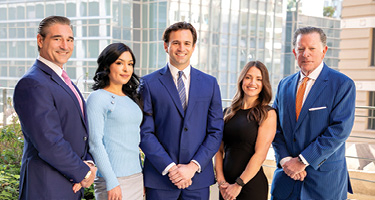On Oct. 1, as the devastation wrought by Hurricane Helene became all too clear, Alice Mine, executive director of the North Carolina State Bar, put out an urgent call to lawyers in neighboring states.
North Carolina’s chief justice had just issued a “Katrina order.” The order would allow lawyers from other states to temporarily register and provide pro bono legal services to indigent victims of the storm. The hurricane would mean an increase in disputes between landlords and tenants and a spike in consumer fraud cases. Most importantly, victims would need help with their applications for assistance from the Federal Emergency Management Agency.
Within a few days, more than a hundred lawyers had registered with the state bar, with more applications coming every day. Still, weeks after the fact, demand for pro bono help remains high: “I am told that the need for volunteers will continue for, possibly, up to a year,” Mine wrote in a message to the Southern Conference of Bar Presidents. “So anyone who volunteers will be put to good use.”
Disasters like Hurricane Helene underline the critical impact lawyers doing pro bono work can have for clients facing desperate or even life-threatening, circumstances. The American Bar Association recommends that lawyers commit to at least 50 annual pro bono hours for clients who are unable to pay, as do state bar associations in New York, California, the District of Columbia and Texas, among others. Other state bars, like Florida, Nevada and Missouri, recommend a minimum of 20 hours.
Every year, Best Law Firms® surveys thousands of law firms as part of its ranking process and asks them about their pro bono efforts. The results provide a window into how much pro bono work firms are doing, the resources they are dedicating to pro bono and the incentives they provide lawyers to take on critical pro bono tasks—like advising hurricane victims.
Pro Bono Hours
In response to this year’s requests from Best Law Firms, 730 firms provided the annual number of pro bono hours they performed last year. The firms in this group had an average of 90 lawyers and ranged from solo practitioners to global megafirms.
Taken as a whole, the firms employ approximately 56,000 attorneys who spent more than 1.78 million hours on pro bono projects. On an individual basis, they averaged 31.8 hours of pro bono work—well above recommendations in some states, but significantly below the ABA’s 50-hour target. To reach 50 hours, they would have needed to spend 2.8 million hours on pro bono projects—or roughly 57% more time than they devoted last year.
On the plus side, just over a quarter of the firms reported hourly per attorney averages north of 50 hours, some significantly more so. In many cases, smaller firms and solos are putting in hundreds of pro bono hours per year. Nevertheless, 21% of firms had pro bono averages below 10 hours per lawyer, including several firms employing hundreds of attorneys.
Our survey results show that many firms have work to do to meet their pro bono goals."
That said, the largest firms, with 500 or more attorneys and firms in the middle of the pack—20-150 lawyers—had the highest per-lawyer averages. Small firms with less than 20 lawyers and larger firms with 150-499 lawyers reported significantly lower numbers. Here is how the averages lined up based on firm size:
- Firms with 500 or more lawyers averaged 35.4 pro bono hours per attorney.
- Firms with 150-499 lawyers averaged 21.4 hours per attorney.
- Firms with 50-149 lawyers averaged 37.4 hours per attorney.
- Firms with 20-49 lawyers averaged 39.4 hours per attorney.
- Firms with 1-19 lawyers averaged 16.1 hours per attorney.
Larger Firms, Bigger Infrastructure
More than a third of firms in the 150-499 lawyer range reported per attorney averages of 10 pro bono hours or less. Only 17% of those firms had averages above 50 hours. This is in spite of the fact that as firms grow larger, their pro bono infrastructure dramatically expands.
The survey asked firms if they had a formal pro bono program in place. All firms with 500 or more lawyers had a formal program, as did 90% of firms with more than 100 attorneys. Below 100 attorneys, however, the number of formal programs quickly dwindled. About half of the firms with 20-100 lawyers and 21% of firms with less than 20 lawyers said they operated a formal pro bono program.
Pro bono staff is another key feature that separates Big Law from midsize and smaller firms. Three-quarters of the firms with 500 lawyers or more reported having a pro bono coordinator.
This compares to 44% of firms in the 100-499 lawyer range and less than 10% among firms with fewer than 100 lawyers. Pro bono committees are also more prevalent at larger firms. Overall, about a quarter of firms said they have a committee in place.
In recent years, a growing number of large firms have also been hiring specialists to focus on specific pro bono priorities and to mentor others at their firms. In an interview last year with Law.com, Eve Runyon, president and chief executive officer of the Pro Bono Institute, said that during the last four years, a handful of firms have hired lawyers who are entirely focused on pro bono matters.
Shook, Hardy & Bacon, for example, created a new civil rights and racial justice practice in 2023 using an $8.5 million windfall it won in a prisoner’s rights case.
The Business Case for Pro Bono
Pro bono is certainly about upholding the legal profession’s core public service values. But it can also result in tangible business benefits for law firms. In 2000, Esther Lardent, the Pro Bono Institute’s founder, wrote an influential monograph making the business case for pro bono and laid out what she described as a “hard-headed business rationale for pro bono work and for institutional law firm support for that work.”
Though developed a quarter-century ago, the six key business reasons firms should pursue pro bono work cited in the report continue to resonate. They include:
- Recruitment of new associates and laterals. Supporting pro bono projects can provide a competitive advantage in the battle for talent.
- Retention of productive partners and associates. Pro bono work can also motivate lawyers to stick with a firm by giving them interesting work and a unique law firm culture.
- Training and professional development. Firms can use pro bono to create cost-effective training opportunities for attorneys on a wide variety of legal skills.
- Evaluation, supervision and mentoring. Partners working with a pro bono team can provide real-time oversight and feedback to associates.
- Enhancing firm morale and loyalty. Pro bono matters offer the chance for lawyers, particularly at larger firms, to work as a team on engaging work for the public’s benefit.
- Marketing the firm. Pro bono can be a key component of marketing efforts, lending the firm greater credibility, raising its visibility, improving client relationships and generating new business.
“The indirect effects of a pro bono program can have a positive impact on revenue by enhancing and supporting firm goals and activities that create a competitive edge for law firms,” Lardent wrote.
Incentives to Pursue Pro Bono Work
If pro bono can contribute to the bottom line, even indirectly, firms would be well-advised to encourage lawyers to take on the work. The Best Law Firms survey asked firms about the incentives they provide lawyers to participate in pro bono matters, including whether they give lawyers a billable hour credit for pro bono and if those credits are offered with or without limits.
The survey found that the smallest firms were the most generous in offering lawyers credit for pro bono work. Among firms with less than 20 lawyers, 39% said their attorneys receive billable hour credit and 22% allowed lawyers to receive credit with no limits.
Firms may be missing out on significant business opportunities to improve training, morale, recruiting and retention and to burnish their image with current and potential clients."
Only 2% of firms said they offered billable hour credit within set limits. At larger firms, billable hour credit appears to be far less common. Just 14% of firms with more than 20 lawyers said their lawyers receive billable hour credit. Less than 5% of lawyers could receive credit with or without limits.
In addition, the survey asked firms with annual limits on billable hours to share the maximum number eligible for credit. Given that most surveyed are not offering credits, the number of firms providing information was limited. Among the firms that did respond, however, the median limit was 50 hours.
Firms at the bottom end of the scale capped billable hour credit at 20 hours. On the upper end, a few firms set limits at 100 hours or more.
A Growing Need
The relative dearth of hourly credit at firms may make it less attractive for lawyers with high billable hour requirements to devote additional time to pro bono work. Meanwhile, the need for pro bono assistance continues to grow.
The Legal Services Corporation, the federally funded nonprofit that provides grants to civil legal aid groups, regularly reports on the status of access to justice by low-income Americans. In its most recent report, the LSC said the legal aid organizations it funds “do not have enough resources to meet the current demand for civil legal aid in the communities they serve.”
LSC-funded organizations are approached for help on as many as 1.9 million civil legal problems per year and because they lack funding and pro bono support, they must turn away half of those requests. In those cases where they are able to provide assistance, the organizations do not have the resources to fully resolve them.
“All in all, LSC-funded organizations are unable to provide any or enough legal help for an estimated 1.4 million civil legal problems (or 71% of problems) that are brought to their doors in a year,” the LSC said.
This is on top of disasters like Hurricane Helene, which add to the pro bono workload and require emergency action from lawyers in multiple states. “Low-income Americans either do not receive any legal help or do not receive enough legal help for the vast majority of their civil legal problems,” the LSC said.
ABA Model Rule 6.1, which establishes a lawyer’s professional responsibility to provide pro bono service, states that every lawyer, regardless of their professional prominence or workload, has a responsibility to provide legal services to those unable to pay. And “law firms should act reasonably to enable and encourage all lawyers in the firm to provide pro bono legal services called for by this rule,” the ABA says.
The survey results from Best Law Firms show that many law firms have work to do to meet these goals.
Many firms have yet to formalize their pro bono programs and lack incentives to encourage lawyers to take on additional pro bono work. As a result, they are contributing far fewer per lawyer hours than recommended by the ABA or their state bars. In doing so, firms may be missing out on significant business opportunities to improve training, morale, recruiting and retention and to burnish their image with current and potential clients.
Click here to read the full Best Law Firms Legal Market Report 2025.
David L. Brown is a legal affairs writer and consultant, who has served as head of editorial at ALM Media, editor-in-chief of The National Law Journal and Legal Times and executive editor of The American Lawyer. He consults on thought leadership strategy and creates in-depth content for legal industry clients and works closely with Best Law Firms, as senior content consultant.














